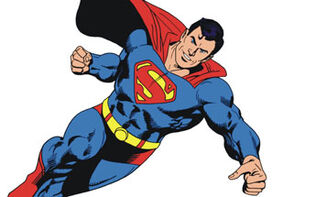
Superman, the most influential superhero and arguably the first superhero
A superhero is a heroic archetype and is usually a person with extraordinary skills or abilities who acts (or should act) out of respect for the greater good of all people. Superheroes, in most cases, have dedicated themselves to help make the world a better place, usually by fighting villains or by averting some other disaster, often risking their lives in the process.
Traits of a Superhero
There are several traits that define a superhero. Though not all superheroes need the following, these things are often associated with superheroes, including attitude, paraphernalia, and capabilities
Costume
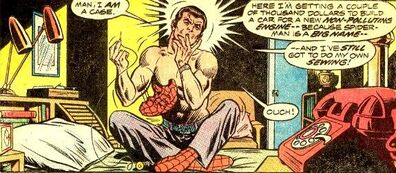
Some heroes must make their own costumes.
The costume is one of the most recognizable aspects of a superhero, though not all superheroes wear them. Costumes allow the hero to be instantly recognized as a unique individual as most heroic costumes would not be confused with day-to-day wear. Costumes also often reflect the nature of the hero who wears it. Costumes may also, (usually when paired with a mask) provide anonymity for superheroes who wish to protect their true identity. Though a smaller percentage of heroes wear them on the whole, capes are a very iconic element of the superhero costume, thanks in no small part to the impact of early superheroes such as Superman and Batman.
A superhero's costume is most often (though certainly not always) a body suit that allows for maximum mobility and flexibility, as many participate in hand to hand fighting, or activities that need to allow as much freedom of movement as possible. This has caused some to joke that they are fighting in long underwear or in spandex (which is not uncommon). There are also many heroes who wear costumes that are alterations or variations on everyday clothes (jeans, coats, boots) and are usually custom made. Other "costumes" may function more as a suit of armor, to protect the wearer from damage. Heroes who worry about less about movement (magic practitioners, for example) may prefer something like flowing robes or something less common.
The suit often has an insignia or motif that matches the heroes name, ability or theme. It is common for superheroes who are part of teams to wear a uniform to show their alliegance. Most costumes use bright, primary colors, with blue and red being the most commonly used colors. It is not uncommon for a hero to change his costumes, for any number of reasons. It could be that there's a new costume with more advanced technology, a sign of a personal change of some sort or simply a desire to were something different. In the case of more iconic heroes, it is usually a significant event if a hero changes his costume.
There are many costumes that in fact imbue their heroes with powers, or enhance them. In cases such as these, the wearer could not be a superhero without them. Similarly, some super-heroes may magically transform into their costume. It is also common that many seemingly simply looking costumes hide gadgets and tools, or be more durable then their appearance. Often, a suit is designed for the powers of the individual (a person who controls flame has a fire proof suit) and can allow them to control their powers.
Though it is less common, there are superheroes who don't wear costumes, usually those who are unconcerned with anonymity or making a statement. In other cases, it is simply because the character may not need clothes (such as a robot or an alien) or are wearing clothes that were not intended as a costume but became part of the character's "look".
Mask
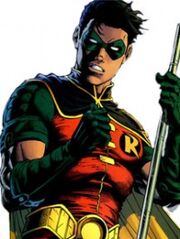
Robin's mask is a traditional example of a domino mask.
A great number of superheroes wear a mask of some sort. This allows the hero in question to protect his identity while in public. Some heroes, however, may simply wear it for aesthetic reasons. Other common reasons include the idea that their mask has a connection to their superpowers (such as the Mask) and/or acts as armor (Iron Man). Still others may could do wer wear a mask due to shame of any deformities or scars they may have (The Thing wore a mask for a time after sustaining injuries from Wolverine). Common masks include full face masks that cover the whole head, domino masks held on with spirit gum, cowls that cover the upper part of the face, or bandannas that cover the mouth (The Shadow) or a cloth bandanna-like masks for the eyes (the Teenage Mutant Ninja Turtles). Cowls are also common to cover most of the head. And though they aren't masks, some heroes use hoods or a mask/hood combination.
Like the costume, the mask also usually follows a particular theme and in almost all cases works as part of the costume. Often it will also hide the pupils of hero wearing the mask, making it harder to read their expressions and intentions. This, of course, can also extend to the full face mask. The full face mask can hide other elements of the character such as his or her ethnicity and even gender, which can help in audience identification with the character. Masks may also be more functional and may have something in it was could, through technology or magic, allow the wearer to see or scan things they otherwise wouldn't be able to,
Teams
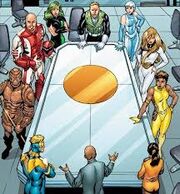
Superhero teams are very common and though some heroes and anti-heroes may be known as loners, there are very few famous heroes who haven't been on a team at one time or another. Some teams are as small as duos and can be as large as thousands and can come together for a large number of reasons: fighting crime, exploration, rescue, etc. most of which are selfless in nature.
The reasons for heroes forming a team are numerous, but there are common reasons for a team's formation. Often, established heroes form teams to deal with problems and situations that are far to dangerous for a single hero to deal with alone, to combine resources to accomplish a larger goal or to expand their ability to help people in a better way. For example, The Justice Society of America was comprised of superheroes who had been successful on their own banded together when they faced a threat that was far to great for them to face alone, while the Authority formed in an attempt to force social justice into the world. In other cases, they may be unique individuals (in some cases, not heroes until they choose to form a team) who form a team due to a connection or common factor between them, usually working toward a common, altruistic goal. The Doom Patrol and the X-Men banded together due to being outcasts fighting both for other outcasts and to protect the same society that rejects them, for instance. And in some cases, the team formed under natural circumstances (such as through family) or are brought together by some larger situation.
In other cases, they may have a shared origin and/or have known each other previously. The Fantastic Four was a family of sorts prior to getting their powers and were already a team. Gaining superpowers simply allowed them to act as a superhero team, as well as a family. Similarly, teams like the Incredibles, ClanDestine, and the Nobles are families whose members are all superheroes.
Secret Identity
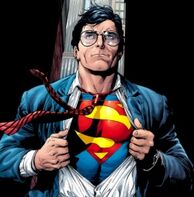
Secret identities and alter egos are often used by superheroes for a variety of reasons, which means that in most cases, superheroes fight crime anonymously in a different guise. In many cases, heroes disguise their identity for fear of retribution from an enemy or a criminal, and in fact many heroes have lost loved ones to villains who have discovered their secret identities (most famously, Spider-Man's girlfriend being murdered by the Green Goblin). Secret identities allow superheroes to lead a relatively normal life more akin the rest of society, although these secrets often lead to dilemmas where the character may damage their personal life for the sake of helping people as a superhero. In many cases, a hero must find a way to solve a situation that could be solved at the expense of their identities, which may have bigger repercussions later on.
Death
Due to the nature of long-term serialized story-telling it is common that death is impermanent in the world of superhero fiction. Often, this means that characters die, only to be ressurected in later stories in one fashion or another. Originally, the killing of a major superhero character was extremely rare. There certainlty notable exceptions, such as comic book story in which the Doom Patrol sacrificed their lives to protect the innocent from their arch-enemies or Captain America revealing that his sidekick, Bucky, died in action. However, in the Bronze Age, there were more notable deaths of major characters such as Aquaman's son, Gwen Stacy (Spider-Man's love interest) and Jean Grey. Though some of these characters remained dead, in many cases, characters would be ressurected or revealed to have never died, which has become common place in superhero comic books.
Public View
For the most part, people in comics handle those with powers much better then the real world would. Almost all heroes in comics are loved by the public, however there are exceptions. In particular, the X-Men are known to be hated and feared by the general populace.
Marvel tends to have their characters have skeptics, and both Marvel and DC have created comics about the Government trying to regulate superheroes so that only ones who work for the government are legal superheroes.
Batman has been known to be mistaken by some characters for an urban legend at times.
